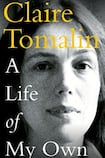
A little more than halfway through A Life of My Own, Claire Tomalin's husband is killed on the Golan Heights by a Syrian heat missile while covering the 1973 Arab-Israeli War for the Sunday Times. Tomalin announces with startling honesty: "I grieved. But I also thought 'NOW!' What did this NOW mean? That I was released from a contract. That from now on, I was in sole charge of my own life, of my four children…not only could but must start again, and choose and make my own life. That everything was changed. That I was already standing alone and not afraid."
Nick Tomalin, charming and talented, was not a dependable husband. His wife had endured various infidelities as well as occasional physical violence. “I was driven to make progress in my career by my husband’s not infrequent decisions to abandon the family.” Tomalin was already relying on herself, juggling the beginning of a dazzling literary career while rearing four children.
A gifted biographer with a wonderfully light and pin-precise touch, Tomalin has compressed her own difficult, often tragic yet highly successful life into a surprisingly compact volume.
By 1973 Tomalin had already lost one child and learned to cope with her youngest son’s disability: Tom was born with spina bifida. Seven years later her second child Suzanna would take her own life.
It is impossible to cover all aspects of this riveting life but the turning point which coincided with her husband’s death reflects her place at the centre of the great changes that were taking place in women’s lives during the second half of the 20th century. Playing her important part took courage even if she concludes that “looking back, I see that I was following trends and general patterns of behaviour which I was about as powerless to resist as a migrating bird or a salmon swimming up stream”.
Women artists
Her near contemporary, the distinguished poet, novelist and fellow biographer Elaine Feinstein, has described their generation as “pioneers”. Like Feinstein, Tomalin read English at Newnham College, Cambridge in the 1950s and had to make her way in a world where women writers were an anomaly.
The theme of women artists coping with adversity is there right from the beginning in the story of Tomalin’s parents. Her father Emile Delavenay, a brilliant French student, came to London to learn English where he met Muriel Herbert, a gifted composer and musician. Tomalin inherited the habit of hard work and dedication from both parents: “For the moment they were equals, both poor, both ambitious, neither with any idea of the future…both feeling their way. Neither had any support or advice at hand.”
Having started together so happily, the marriage proved to be a disaster. Muriel’s musical career was sidelined as she was forced to find a routine job to support her children to prove she was not insane, “…our father had set up divorce proceedings, claiming that our mother was insane – this would give him custody of the children.”
Her friendships with writers and journalists and her experience of the ruthless Murdoch machine give us a fascinating look at those years
The shadow of death which crossed Tomalin’s own life several times hovered over her conception in 1932. She would never have known about it if her father hadn’t shared some pages of his autobiography with her in 1991. Tomalin’s matter-of-fact narration, the absence of any self-pity makes the description of his feelings towards her mother even more chilling: “…on holiday in Cornwall with her and walking in silence on a high cliff path, he felt such hatred for her that he thought seriously of killing her. He reasoned that if he pushed her over the cliff edge no one would ever know it was an accident.”
Tomalin was conceived that night.
A true reader
Despite being “crushed and partly destroyed”, Muriel, another pioneer, succeeded in supporting Tomalin and her sister, helped on her feet in the beginning by a generous friend who invited mother and children to share her home.
Both parents had a gift for the strong friendships which are so much part of Tomalin's life too – notably among the literary and artistic community of London's Gloucester Crescent which featured in Love Nina, Nina Stibbe's hilarious account of her life with Tomalin's neighbour, Mary-Kay Wilmers.
After Nick's death, Tomalin became literary editor of the New Statesman and later the Sunday Times. Her friendships with writers and journalists and her experience of the ruthless Murdoch machine give us a fascinating look at those years – the politics, the history, the last of the hot-metal printing. When Murdoch ordered his staff to Wapping in 1986, Tomalin refused to go, finally settling down to concentrate on her career as a literary biographer already begun in 1974 with her acclaimed life of Mary Wollstonecraft.
Dismissing her own ability to write poetry early on, Tomalin found her “true vocation” and “great happiness” in the field of literary biography. Her meticulous, empathetic biographies, like this memoir, send the reader back in dizzy delight to books and more books. Tomalin is a true and infectious reader, a legacy from her mother who told her “that whatever happens to you, however unhappy you might be, you can escape into a book”.
Martina Evans’ latest book is The Windows of Graceland: New and Selected Poems (Carcanet)












